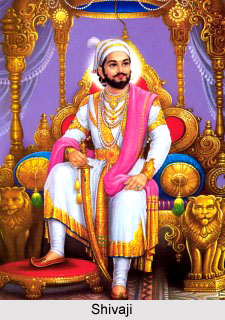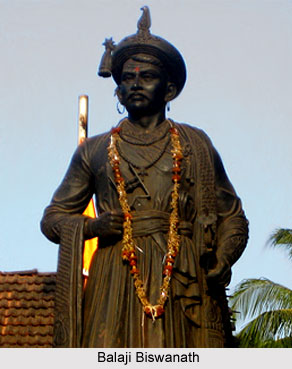 The Marathas were the most violent tribes who established a strong confederacy in India. After a protracted struggle with the Mughal emperor Aurangzeb, the local lord Shivaji established an independent Maratha nation in 1674 with Raigad as its capital. The efficient administration of the Marathas in the 18th and 19th centuries was a combination of the Hindu and the Mohammedan institutions. Though the Marathas were the Hindus, yet there were some Muslim norms, which were followed, in the Maratha administrative system. Moreover with the introduction of the Peshwa Raj several changes were adopted in the administrative system of the Marathas.
The Marathas were the most violent tribes who established a strong confederacy in India. After a protracted struggle with the Mughal emperor Aurangzeb, the local lord Shivaji established an independent Maratha nation in 1674 with Raigad as its capital. The efficient administration of the Marathas in the 18th and 19th centuries was a combination of the Hindu and the Mohammedan institutions. Though the Marathas were the Hindus, yet there were some Muslim norms, which were followed, in the Maratha administrative system. Moreover with the introduction of the Peshwa Raj several changes were adopted in the administrative system of the Marathas.
The head of the Maratha Empire was the Raja of satara. He was generally known as Chatrapati. Though constitutionally all the powers were bestowed on Chatrapati, but the Peshwa actually performed all the administrative duties.
The Peshwa was originally a member the Astha Pradhan Council of Shivaji. As is known from the contemporary records, Peshwa holds the second rank in the council of minister. Balaji Biswanath was the most famous Peshwa of the Maratha confederacy. He was the seventh Peshwa of the Maratha House. By his ability and statesmanship he made the Peshwaship hereditary. His son Baji Rao made the Peshwaship preeminent. Under the supremacy of the Peshwaship, the Maratha king with the passage of time ceased to be the real administrator. As the authorized deputy of the Maratha king the Peshwa exercised all the royal prerogatives, adopted the policies and strategies etc. Thus the Peshwa Raj established its strong foundation in the Maratha administrative system. They introduced new systems in the executive, legislative and the judicial administration.
The Peshwa secretariat at Poona called the Huzur Daftar. This Huzur Daftar was the focus of the Maratha administration. It was a huge establishment and had several departments and bureaus. All accounts and revenues of the Empire were maintained by the Secretariat. The Rozkirds (daily registers) recorded all revenue transactions. Moreover the Rozkirds registered the grants and payments and particularly the accounts of all contributions and exactions levied on the foreign states etc. The most important departments were the El Beriz Daftar and Chalte Daftar. The former dealt with the accounts of all sorts and was located at Poona. It maintained classified accounts from all other departments. The El Beriz Daftar created a thorough index of the total receipt, expenditure and balance of the state`s income in a year. This index was known as Tarjuma. The Chalte Daftar was under the direct charge of the Fadnavis. Nana Fadnavis introduced many improvements in the working of the Huzur Daftar.
The provincial administration was extremely strong under the Peshwas. The entire Maratha Empire was subdivided into Tarf, Pargana, Sarkar and Subah. The Subah was styled as a Prant and a Tarf and a Pargana or Mahal also. The big provinces of Khandesh, Gujrat and Carnatic were under officers known as Sarsubahdars. The Sarsubahdars appointed their own Mamlatdars who acted as the Deputy of the Sarsubahdars. Next in the rank of the Sarsubahdars were the Mamlatdars. Mamlatdars were assisted by the Kamavisdar in their work. The Mamlatdar and the Kamavisdar were the representatives of the Peshwas in the provinces. The Kamavisdar and the Mamlatdars looked after the development of agriculture and industry, civil and criminal justice, control of local militia, the police and even arbitration in social and religious disputes. The revenue assessment of the village was in the provinces was looked upon by the Mamlatdars in consultation with the Patels in the villages. In case of need the Mamlatdar also helped the Patels with militia in matters of revenue collection. The salary and the prerequisites of the Mamlatdars and the Kamavisdar differed from district to district. In Shiavaji`s time these posts were transferable. But the Peshwas made these posts hereditary. The Deshmukh and the Deshpande were the other district officials who also performed several important duties. The smaller administrative divisions were called Mahals or Tarfs. The chief officer in a Mahal was called the Havildars.
The village communities during the Marathas functioned as the local units of administration. The village communities during the Marathas enjoyed autonomy in their local affairs. Thus the villages were self-supported. The chief village officer was Patel, who performed the tasks like judicial, revenue and other administrative functions. Patel served as the link between the village and the Peshwa. However the Patel`s s office was hereditary but could be sold or purchased. The Patels did not receive any salary from the state and his remuneration consisted of the share of every villager produce Thus the Pastels became the social leaders of the village. Moreover the Patels were responsible for the payment of the stipulated revenue from the village to the government. If the Patels somehow failed to collect the revenues properly he was liable to be imprisoned. Next in rank to the Patels were the Kulkarnis. The Kulkarnis are actually the village clerk and the record keeper. Like the Patels the Kulkarnis were also presented by the villagers by prerequisites. There were also several subordinate officers who assisted the Patels and the Kulkarnis to execute their duties properly.
 The pattern of the Maratha town administration was very much conforming to the Maurya town administration. The Kotwal was the chief administrator of the Maratha city. His duties included the disposal of the important duties, regulation of prices, maintenance of a record of a person coming in and going out of the city and, arbitration in dispute relating to roads, lanes, houses and upkeep and transmission of monthly accounts to the government. Above all the Kotwal was a Police magistrate and at the helm of the City Police.
The pattern of the Maratha town administration was very much conforming to the Maurya town administration. The Kotwal was the chief administrator of the Maratha city. His duties included the disposal of the important duties, regulation of prices, maintenance of a record of a person coming in and going out of the city and, arbitration in dispute relating to roads, lanes, houses and upkeep and transmission of monthly accounts to the government. Above all the Kotwal was a Police magistrate and at the helm of the City Police.
The Maratha law followed the norms of the old Sanskrit treatise of ancient India. The Peshwas followed the laws of Mitakshara and Manu`s code in the judicial administration. The judicial officer in the village was a Patel and in the district set up was the Mamlatdar. Above the Mamlatdar were the Sarsubahdars. In towns the judicial duties were entrusted to the care of a Nyayadhis. The Nyayadhis was a judicial officer, who should be well versed in the Shastras. This Nyayadhis were only entrusted to perform the judicial functions. The judicial system under the Peshwas was very simple and flexible. There was no codified law and no set of procedure for the trial cases. In the judicial cases the Chatrapati and the Peshwas acted more like patriarchs of old judges. The Panchayat was the main instrument of civil justice. In the villages the civil and the criminal cases were usually controlled by the Panchayats.
The Peshwas in order to maintain the peace and order in the society strengthened the police administration. The metropolitan Police at Poona was very much efficient, which controlled the civil and social order in the state.
Since agriculture was the principal industry of India, land revenue formed the main source of income of the Peshwas. The Peshwas controlled the land revenue in their own way, which was different from the system initiated by Shivaji. The Peshwas gave the grant of land on long lease on a fixed state demand. To give inducements to the cultivators and to bring more lands under cultivation the Peshwas followed special policy. In this policy the new lands, which were brought under cultivation, were lightly taxed by the Maratha Peshwas. The Peshwas also promoted the cultivation of the rocky or the wasteland. In times of famine, drought or plunder of crops or failure of crops, remissions of land revenue were granted. To save the cultivator from the moneylenders the state granted tagai loans at low rate of interest. However the state demand as well as the mode of payment of land revenue was not uniform throughout the Empire. Thus the revenue system of Marathas was based on the security of the taxpayer.
Thus under the Peshwaship, Maratha power established a strong foundation of the efficient administration.



















